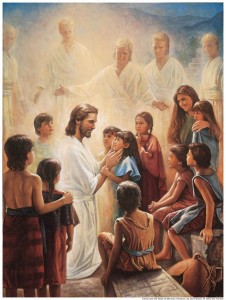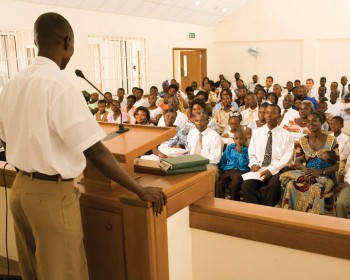Mormons (a nickname for members of The Church of Jesus Christ of Latter-day Saints) use a few more books of scripture than most other Christians. Their set of “standard works” (books of scripture) are the Holy Bible, the Book of Mormon, the Doctrine and Covenants, and the Pearl of Great Price.
The Bible
 Mormons use the King James translation of the Bible in English-speaking congregations and other translations for other languages. They use both the Old and New Testaments and in a four-year rotation of scripture study in formal classes, the Bible receives two of these years. Adults study the Bible for two years in Sunday School. Teens also study it for two years in Sunday School, but in addition, they study the Bible for two years in a class called Seminary. This is an academic and spiritual class taught five days a week during the school year and is an in-depth study. College students and some adults have a similar college-level study in a program called Institute of Religion. Older children ages eight and up study the Bible for two years and younger children study it every other year. Of course, families and individuals also conduct personal and family study of the Bible.
Mormons use the King James translation of the Bible in English-speaking congregations and other translations for other languages. They use both the Old and New Testaments and in a four-year rotation of scripture study in formal classes, the Bible receives two of these years. Adults study the Bible for two years in Sunday School. Teens also study it for two years in Sunday School, but in addition, they study the Bible for two years in a class called Seminary. This is an academic and spiritual class taught five days a week during the school year and is an in-depth study. College students and some adults have a similar college-level study in a program called Institute of Religion. Older children ages eight and up study the Bible for two years and younger children study it every other year. Of course, families and individuals also conduct personal and family study of the Bible.
Mormons believe the Bible to be the word of God as it was first written by the original authors. However, the translators were not necessarily always perfect and we know portions of the Bible are missing, since some writings are mentioned that we do not have. For this reason, they add a caveat that it is the word of God insofar as it is correctly translated. This is a necessary notation since there are many, many translations of the Bible and all differ from each other. They cannot, of course, all be correct, particularly in areas in which they conflict.
The Church of Jesus Christ of Latter-day Saints began with a Bible. Joseph Smith, the first prophet and president of the Mormons, was fourteen when he started wondering which church to join. He visited many local churches but found their teachings contradicted one another and yet they all said they had the complete truth. He couldn’t figure out how someone could know with any certainty. While reading the Bible, he found a verse in the New Testament: James 1:5, which explained that if a person lacked wisdom, he could ask God and God would answer him. This, of course, made complete sense to young Joseph. Only God knew which church was right. He went into the woods and prayed to know which church to join. God and Jesus Christ appeared to Him in this grove of trees and Jesus instructed him not to join any of them because none had the complete truth. In time, Joseph Smith would be prepared by an angel to restore lost truths. This foundation of a Bible scripture makes the Bible very precious to Mormons.
The Book of Mormon
The Book of Mormon does not replace the Bible. Instead, it testifies of its truthfulness and the divinity of Jesus Christ. The Book of Mormon is much like the Bible in its structure. It is a collection of records by many different prophets who testify of Jesus Christ and record God’s dealings with their people. However, it takes place somewhere on the American continent (Mormons do not know where the events occurred, although scholars enjoy trying to figure it out).
The book’s events begin during the time of the Biblical prophet Jermiah, prior to the fall of Jerusalem. One of the many prophets testifying of that time, Lehi, left Jerusalem with his family under instruction from God. They eventually end up in the Americas, where they set up a civilization comprised of two warring factions, both deriving from sons of Lehi. Lehi’s family did not come to an empty continent, and Mormons do not teach that all (or necessarily any) of the American Indians are the ancestors of these people. Some individual Mormons, including church leaders, believed they were, in part because other civilizations are not mentioned, but scholarly studies by LDS organizations have shown that population studies demonstrate the continent was previously populated. Mormons believe that science is not doctrine and only those things which impact salvation are doctrinal and important. Everything else is just interesting.
During the generations this population existed, Jesus Christ was born in the Holy Lands. After his death and resurrection He visited these people for a few days, teaching them and helping them properly organize their church. This proves the divinity of Jesus Christ, since he came to a group of people who lived far away. It also demonstrates Jesus is the God of all people, not just those living in the Holy Lands during Jesus’ time. His concern has always been for all the world’s children.
In time, the two warring factions would reach a critical crisis and the once valiant people would be destroyed by the wicked faction. At age 24, under instruction from a previous prophet, Mormon, for whom the Book of Mormon is named, took the records from a hiding place and began to condense them. Soon after the large battle that killed many of the Nephites (the name of the once-righteous people) were killed, Mormon himself was killed. His son Moroni, believed to have only been a teenager, became the last remaining person of his people, the last good person in his personal world.
In hiding as the wicked faction tried to find him and murder him, he completed the work his father had started and also finished recording the history of his people. He buried the records and fled for his life. He returned once, many years later, to add to the book, but then fled again. He would later return as an angel to prepare Joseph Smith for the restoration.
The Doctrine and Covenants
The Doctrine and Covenants contains revelations and inspired declarations from the restored modern church. Most of the revelations were given to Joseph Smith and help to document the organization of the Mormon church. They also clarify and explain new doctrine and outline God’s expectations for all people in modern times. It is different from the other “standard works” of the church because it is not translated from ancient records.
The revelations clarify many truths that have puzzled theologians for centuries or that have become lost or changed by various religious leaders over time. When there was no prophet, churches that disagreed over specific doctrine had to put truth to a human vote, which frequently led to the formation of new churches with conflicting doctrine. Only when a prophet is on the earth can we know for sure how God wants the Bible interpreted and the gospel lived.
Some of the doctrines outlined in this powerful book include the nature of God and Jesus Christ, Satan’s reality and power to fight against God’s plan, and the divinity of Jesus Christ. It helps us understand what happens after death, including to infants who die without baptism, and the eternalness of the family. Throughout it all we gain a clearer understanding of how much God loves us and how involved He and the Savior are in our lives today.
Changes have been made to the book from time to time. New revelations have been added. One volume contained a series of lessons on the gospel but they were removed from later editions because they were not revelations and it was decided to keep the book focused on that topic. The most recent edition added three new documents to the book. Of course, some historical corrections to the headings and summaries were also made and study materials have been added.
The Pearl of Great Price
This very small book contains some of the most fascinating theological writings found today. The book originated in 1851, when Elder Franklin D. Richards , an apostle, wanted to make some important documents more available to church members . These documents were available locally, but the church now existed in areas around the United States and Europe. It became official scripture in 1880.
The first section of this book contains a portion of the book of Genesis from the Bible, which Joseph Smith had translated. He died before his translation was complete, but portions are still used today to facilitate understanding. This section contains scriptures relating to Moses that occurred after the burning bush but before the Exodus and includes information and events not included in the Bible, but which provide critical information about the gospel of Jesus Christ.
The Book of Abraham is the second section and is a translation of some papyri Joseph Smith received in 1835. These, of course, contain writings by the Biblical Abraham.
The third section contains a portion of Matthew’s testimony—the Matthew of the New Testament, also translated by Joseph Smith.
The fourth contains excerpts from Joseph Smith’s autobiography, written in 1838.
Finally, the book contains the Articles of Faith. These are thirteen critical beliefs of Mormons. Joseph Smith wrote these at the request of a newspaper editor who wanted to publish an explanation of Mormon beliefs. Children are expected to memorize and understand these by the time they turn twelve and they are considered an essential part of Mormonism.
Did God Forbid Additional Scripture?
There are some who mistakenly believe the Bible says there can be no scriptures other than the Bible. This comes from a lack of knowledge of how and when the Bible was created and from misinterpretation of scripture.
It’s important to understand the Bible was not written as one document, as was the Book of Mormon. It began as a variety of independently written documents and histories. These were not even gathered up until long after the authors were dead, so the scripture found in Revelations about not adding to these things could not possibly refer to the Bible-there was no Bible when that was written.
““For I testify unto every man that heareth the words of the prophecy of this book, If any man shall add unto these things, God shall add unto him the plagues that are written in this book:
“And if any man shall take away from the words of the book of this prophecy, God shall take away his part out of the book of life, and out of the holy city, and from the things which are written in this book.” (Rev. 22:18–19.)
Of course, Revelations was not the last book written, so other documents were created after this scripture was written. John is believed to have written this on the aisle of Patmo, but he began writing his epistles after he wrote this particular warning, so he himself added to the Bible.
This warning is found far earlier in the Bible as well. We find a similar verse in Deuteronomy and spoken by Moses, twice.
“Ye shall not add unto the word which I command you, neither shall ye diminish ought from it, that ye may keep the commandments of the Lord your God which I command you.” (Deut. 4:2.)
“What thing soever I command you, observe to do it: thou shalt not add thereto, nor diminish from it.” (Deut. 12:32.)
Naturally, no Christian wishes to throw out everything in the Bible that occurs after Deuteronomy. Think how much we would miss!
The verses in Deuteronomy make it clear what Paul meant. We are not to change the gospel as it was taught by God and the apostles. It does not mean there can never be new revelations. We know the Bible as we have it is not complete. When it was time to create the Bible, a committee met to decide which of the documents they had found should be included. Not everyone agreed on the selections made, which is why Catholics have a different Bible. In addition, the Bible often mentions writings we’ve never had access to.
The Bible contains many promises that there would always be prophets, even promising never to do anything except through His promises, and vowing to send revelation to us in the last days. It is not the right of humans to forbid God to speak to us. God sets the terms of life on earth; our job is find the prophets He promised us and to listen to their counsel.
Learn more about Mormon scriptures at the official site of the Church of Jesus Christ of Latter-day Saints (inadvertently called by friends of other faiths as the “Mormon Church”).
About Terrie Lynn Bittner
The late Terrie Lynn Bittner—beloved wife, mother, grandmother, and friend—was the author of two homeschooling books and numerous articles, including several that appeared in Latter-day Saint magazines. She became a member of the Church at the age of 17 and began sharing her faith online in 1992.



